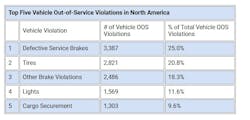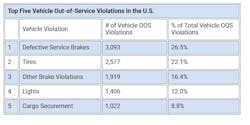2024 International Roadcheck results: defective brake violations top list
The Commercial Vehicle Safety Alliance (CVSA) has released its results for 2024’s International Roadcheck after completing 48,761 inspections across Canada, Mexico, and the U.S. from May 14-16. These inspections placed 9,345 vehicles out of service, with officials serving 13,567 OOS violations in total.
One distinctive shift in 2024’s International Roadcheck results is that the number of Defective Service Brake OOS violations increased from 2,468 in 2023 to 3,387 this year, supplanting Brake System OOS violations as the top issue for vehicles in North America.
“The main reason for the change has to do with how each of the brake violation codes are grouped for data collection purposes,” said Jeremy Disbrow, roadside inspection specialist for CVSA. “In an effort to get more useful data, we updated the violation codes and ensured they were being counted in the proper category. Moving forward, these should remain constant.”
With this update, Defective Service Brake violations refers to 20% brake violations, including improper brake adjustment and worn brake linings. 20% brake violations refers to 396.3(a)(1), which states that if the number of defective brakes on a vehicle is equal to or greater than 20% of the service brakes on the vehicle combination, it should be placed out of service. Meanwhile, the Brake Systems category now refers to major brake components that don’t fall under the 20% brake violation category, Disbrow explained. These problems include stand-alone OOS brake defects such as worn brake hoses, hydraulic brake defects, and inoperable parking brakes.
Due to this change, the 20% service brake rule was the most common issue for Defective Service Brake OOS violations, as it made up 2,700 of the 3,387 violations in this category.
“Again, this number was historically listed under “brake components”, but that was not the most helpful location for it, so it was moved to the “defective service brakes” category,” Disbrow emphasized, explaining why this category of violations ballooned between 2023 and 2024.
These OOS numbers may seem daunting, but overall, both the number of OOS vehicles and OOS violations decreased from last year’s International Roadcheck, potentially due to how there were several thousand fewer inspections this year than in 2023. However, the total overall vehicle out-of-service rate did increase from 19.3% to 23% this year.
While 2024’s vehicle focus area was tractor protection systems (TPS), including the tractor protection, trailer supply, and anti-bleed-back valves, defective service brakes and tire violations were the most common out-of-service issues. Across North America, inspectors found 564 TPS-related violations, 3,387 Defective Service Brake violations, and 2,821 Tire violations. But it should be noted that not all TPS violations could result in an OOS condition, while the Defective Service Brake and Tire violations did.
Read more: CVSA updates OOS violation standards before International Roadcheck
But on the positive side, 17,395 power units, trailers, and motorcoaches/buses had no critical inspection violations, and received a CVSA decal for their efforts.
After Defective Service Brake and Tire violations, inspectors also found 2,486 OOS Other Brake Violations, 1,569 OOS Lights violations, and 1,303 OOS Cargo Securement issues. Taken together, Defective Service Brake and Tire violations constituted 45.8% of total vehicle OOS violations in North America.
International Roadcheck violations in the U.S. also saw the number of Defective Service Brake OOS violations leap from 2,236 in 2023 to 3,093 in 2024. Tire OOS violations remained the second-most common OOS violation (2,577) in the U.S. out of a total of 42,332 inspections throughout the three-day period. There were also 1,919 Other Brake Violations, 1,406 Lights OOS violations, and 1,022 Cargo Securement OOS violations. In total, inspectors found 11,675 vehicle violations and placed 7,930 vehicles OOS in the U.S.
While the changes to violation categorization had the largest impact on which category was the top OOS offender this year, Disbrow noted that the International Roadcheck data still reveals a troubling trend.
“The data shows that brake adjustment is a chronic problem, so carriers need to find a way to address this issue with their drivers,” Disbrow stated. “Drivers should be inspecting their brakes routinely just like the other required components on the vehicle. If a driver is only checking lights and kicking tires during their pre-trip, defects will continue to be missed and brake violations will remain a common problem.”
For Disbrow, this means emphasizing a good maintenance program and quality pre-trip inspections, including making sure that carriers and maintenance teams play a stronger role in safety and compliance. He also added that drivers should not just know how to inspect their vehicles correctly, but should also know which components need to be repaired after the inspection.
“It is, of course, worrisome to carriers when they receive these violations, but the violations are actually the smallest part of the problem for them,” Disbrow concluded. “The bigger problem is the potential liability for them if there is a collision. Even if the CMV is not the “at fault” vehicle, they will likely be sued if there are brake defects discovered during a post-collision investigation, and those lawsuits can be devastating to any motor carrier.”
As a result, Disbrow hopes that the data mined from this year’s International Roadcheck will help motor carriers assess their maintenance programs and driver training for ongoing improvement.
About the Author

Alex Keenan
Alex Keenan is an Associate Editor for Fleet Maintenance magazine. She has written on a variety of topics for the past several years and recently joined the transportation industry, reviewing content covering technician challenges and breaking industry news. She holds a bachelor's degree in English from Colorado State University in Fort Collins, Colorado.


